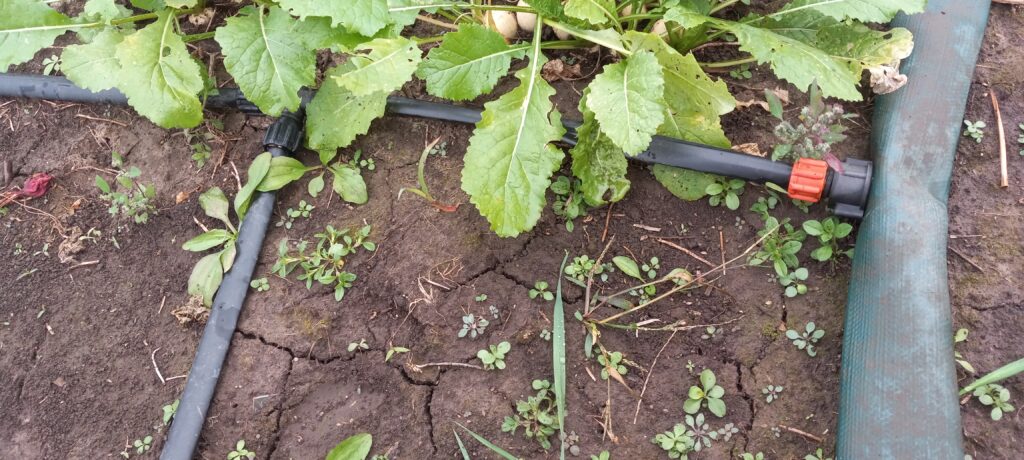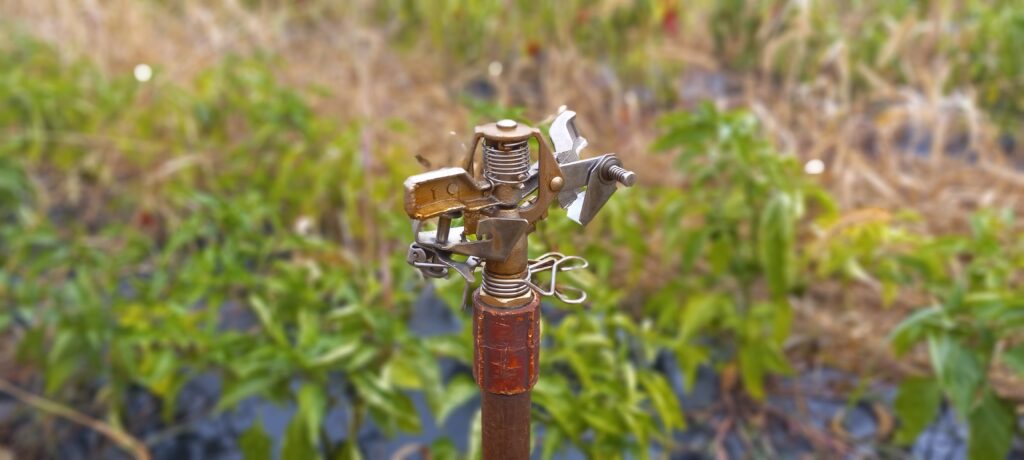
We haven’t sold out yet of 2026 share so you can still join! For returning customers all you need to do is send in a $100 deposit. PayPal, Zelle, check or cash all work. Or you can order though our online store. New customers should go through the store. Let me know if you have any questions!
As of today we believe we have enough produce to make it until the end of October. That still could change but that is our best guess.
We still have honey for sale! Delivery member can order online and we will send it to you in your delivery tote. On-farmers can pick it up and pay during your usual pick-up time.
What will we have this week?
More potatoes, more winter squash, the last of the tomatoes, the last of the beans, some peppers (we managed to keep these alive so hopefully there will be more), shallots, onions, daikon radishes, a few bok choy (wish these did better but we have plans for next season), some arugula, lemongrass (Fun!), some leeks and a bunch of odds and ends.
It is a ‘Shroom, Coffee, Winter and Flower share week. We’ll send out the potatoes for WinterShare this week. FlowerShare will be more pumpkins. CoffeShare is whatever you ordered. ‘Shrooms are black poplar.

Farm News
First of all I want to thank everyone who stepped up and campaigned for the return of “Farm News”. Without your support I would be free to do pretty much anything else with all the time I would save not writing this part of the newsletter. So Thank You for giving me yet another task!
Last week as I was repairing yet another hole in the drip tape (why don’t they make drip tape tape to repair drip tape?) I started wondering whether using drip tape is really worthwhile. The two alternatives to drip tape that we have are using sprinklers (and of course not using plastic mulch since drip tape is required to irrigate below the mulch) or rely on Mother Nature (and of course not using plastic mulch since rain water doesn’t infiltrate below the mulch). So I decided this would be a good topic for a newsletter. It gives me the opportunity to think through the pros and cons and have them written down so the next time I contemplate making a change I can refer back to this newsletter.

So, what is drip tape? Drip tape is a strip of plastic that has holes every foot or so (the distance between holes is one of the options). When connected to a water source water will drip through the holes into the soil. It looks very tape-like. I suppose that is how it got its name.
So, what are the benefits of drip tape? The biggest benefit is that it delivers the water to the roots of the plants thus reducing evaporation, unnecessary watering of aisles and reduction of water use. We can irrigate 20 or so beds at one time with drip irrigation. We can only do 10 at most with overhead. On the other hand, with rain we can get all of them at the same time! One point in the rain column! Wait, the rain doesn’t water the rows that use plastic mulch. Minus one for the rain column.
Another big benefit of drip tape is we can easily cultivate the aisles. With sprinklers we have to move the sprinklers twice to cultivate — once to get them out of the way and another time to put them back. Moving sprinklers isn’t easy. It is time consuming and not easily accomplished by one person. Plus if we have recently sprinkled, the soil in the aisles would be too wet to cultivate. Drip tape eliminates this difficulty.
Another huge benefit of drip tape is that it doesn’t wet the foliage of our plants. Wet foliage tends to promote diseases. By keeping the plants as dry as possible we can reduce our disease pressure. I think this factor alone may be enough to tip the scale toward the use of drip tape.
What are the cons of using drip tape? The primary drawback is it seems to be high maintenance — at least here on our farm. The primary problem is the frequent holes that occur in the tape. The two main culprits creating the holes are critters and farm workers. The gophers tend to chew holes through the drip tape requiring somewhat frequent repairs. We have put a lot of effort into removing the gophers but they seem to procreate as fast as rabbits. We typically reduce the population in the spring when we have time to set and monitor traps. By summer the population seems to dwindle due to this effort. But by fall the mom gophers kick out the kids and they go find a new home — usually somewhere where they can make my life more difficult. So they take up residence in the fields and frequently chew holes in the drip tape or the underground irrigation lines. So frustrating. Mice and/or voles also seem to chew holes in the drip tape. This occurs mainly when we lay the tape on the surface, which we do for shorter term crops like radishes.
The other big hole creators are our employees. If we put drip tape on a bed where we aren’t using plastic mulch — say on cool season crops like cabbage or broccoli — we have to hoe and weed the plants to try to keep the weeds suppressed enough for the vegetable plants to grow. Hitting the tape doesn’t necessarily create a hole in the tape but it is more likely to than not hitting the tape. Even experienced hoers can nick the tape. And if the hoers try to be more careful they tend to miss a lot of the weeds and take a long time. So hoeing over drip tape is problematic.

Also cultivating over drip tape is difficult. Cultivating closer to the plants with the tractor reduces the amount of hoeing but can cause a lot of damage if done incorrectly or if a mistake is made. I’ve cultivated many times over the years and always find it stressful to do on plants with drip tape. If the equipment goes too deep it can destroy the drip tape. If it is too shallow it isn’t effective. Finding that sweet spot on undulating soil is difficult at best. There are tools available that could make it easier but they are expensive and there is no guarantee they would work better than what we have. Too bad there isn’t a rent to buy program for farm equipment.
Another drawback to drip tape is the drip emitters can clog, either with sediment or hard water deposits. For long term crops on plastic we are never quite sure how well the drip tape is working. If we see wilting plants it might be due to insufficient water, but it might also be due to too much water or a disease. In the past we had a set schedule to irrigate mulched crops so that they have by our calculations sufficient water. This season we bought water meters and a moisture sensor. We discovered our timed approach to irrigation wasn’t delivering the amount of water we expected. With this new equipment, I feel we have a better approach to providing the plants with the right amount of water, but it still isn’t perfect. Even using sprinklers doesn’t guarantee even watering. Rain is the only approach that waters everything evenly.
Another drawback of drip tape is trying to manage the weeds around the header lines. Moving the headers is difficult. We can sort of flop them over and mow the area underneath then flop them back into place. But they never seem to get back to the original spot and the process of doing this is time consuming. Plus we’d have to do this every week to keep the weeds down sufficiently. So during the summer when there is so much to do, this task gets pushed to the bottom of the list. I think a lot of non-organic farms just spray Roundup in this area. We don’t use Roundup and there is no organic equivalent. I’m not sure what other organic farms do.

Another drawback that probably should have been mentioned earlier is cost. Drip tape can only be used one season. I suppose some farmers have found ways to reuse it but with the number of holes created by critters on our farm (and for the sake of argument I am also calling our farm workers critters here) it just isn’t feasible. So buying new drip tape every year is a major factor. Plus we have to dispose of the drip tape after we use it. We were very reluctant to switch to drip tape because of this factor but once we found out that Washington County turns all trash into pellets to burn to create energy we felt a little better about using it. It isn’t an ideal solution from an environmental point of view but the benefits — especially water conservation — can compensate for this drawback.
There is also a significant labor cost to installing and removing drip tape. We purchased equipment to install it but rely on human power to remove it. Both are labor intensive. I think an interesting measurement would be to record all the labor time spent on installing, using, repairing and removing drip tape and compare it to the labor time used for overhead irrigation. I would guess the difference isn’t much or if there is a difference it might tip toward overhead being more labor efficient, which would have surprised me if I hadn’t used drip before. But with the reduction in water use; the reduction in disease pressure; and the benefit of using plastic mulch for weed suppression and frost prevention, I think drip still comes out on top for the long term crops.

Parsley Potatoes
Ingredients
- 1 lb potatoes
- 4 Tbs butter
- 1 small bunch parsley chopped
- 1-3 Tbs lemon juice to taste
Instructions
- Wash potatoes. Leave whole.
- Place washed potatoes in pan. Cover with water.
- Bring to boil. Cook until soft — approximately 20 minutes
- In another pan, melt butter.
- Add chopped parsley and lemon juice to melted butter. Mix.
- Once potatoes are soft, drain and put into bowl.
- Slightly smash potatoes.
- Add butter mixture to potatoes and mix.
Joke of the Week
My friend saw I was upset the other day and said “It could be worse. You could be a deep hole used to get underground water to the surface.”
It didn’t help, but I knew he meant well
As always, do not hesitate to send in questions, comments, suggestions, jokes and 2026 share orders!
